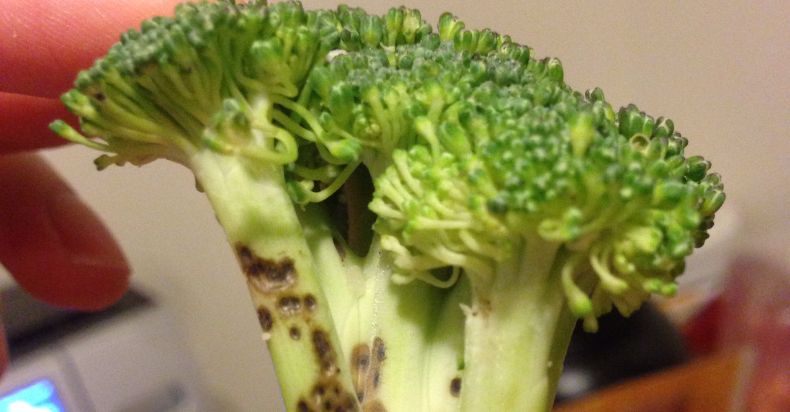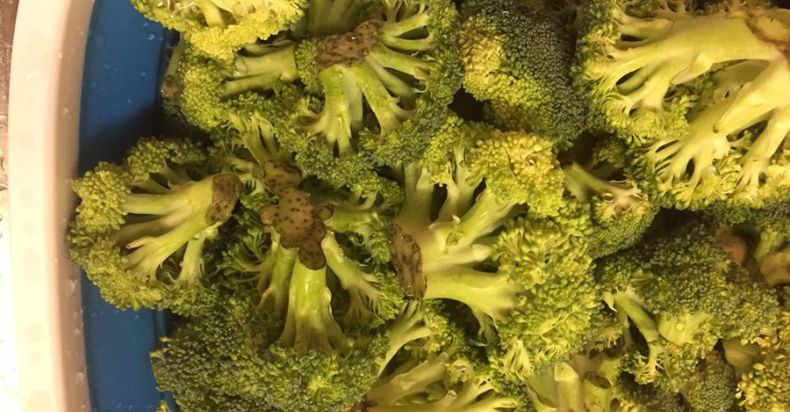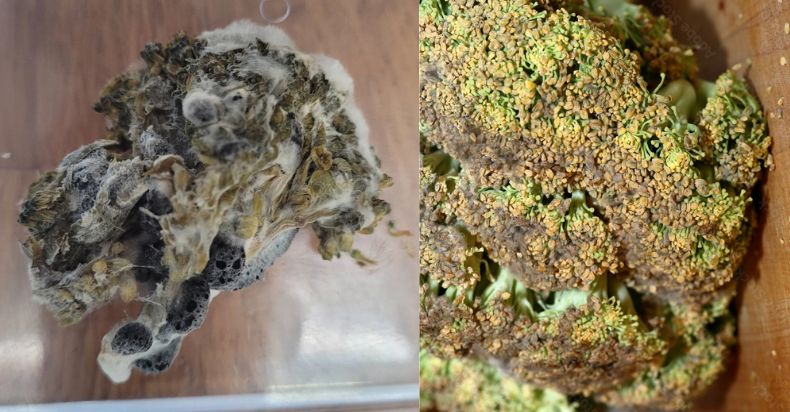So, you’ve got a head of broccoli in your fridge, and you notice some brown spots. You’re probably thinking, “Huh? What’s this all about?” Well, you’re not alone. Many people wonder if it’s safe to eat broccoli with brown spots. It’s a common question, and we’re here to answer it.
So, sit back, relax, and let’s dive into the world of broccoli, shall we?
What Causes Brown Spots on Broccoli?

First things first, let’s talk about why your broccoli might be sporting those not-so-fashionable brown spots. “Ok… sooo,” you might ask, “what’s causing my broccoli to turn brown?”
Well, the answer is quite simple. Brown spots on broccoli are usually caused by oxidation. This happens when the broccoli is exposed to air for a prolonged period. It's the same process that turns your apple slices brown when you leave them out.
But let’s dive a bit deeper into this. Oxidation is a chemical reaction that occurs when certain molecules (in this case, those in your broccoli) come into contact with oxygen.
This reaction causes the molecules to change, resulting in a different color – brown. It’s a completely natural process and happens with many fruits and vegetables, not just broccoli.
Another reason could be a fungal or bacterial infection. These organisms can cause the broccoli to develop brown or black spots. This usually happens when the broccoli is kept in warm, humid conditions, which are perfect for these microorganisms to thrive.
But don't panic just yet! It doesn't necessarily mean your broccoli is unsafe to eat. In fact, these spots are often just superficial and can be cut off. However, if the spots are deep and the broccoli has a slimy texture or an off smell, it's best to toss it.
Lastly, brown spots can also be a sign of aging. Just like us, fruits and vegetables age over time. As broccoli ages, it can develop brown spots, especially if it’s been sitting in your fridge for a while.
So, there you have it! The mystery of the brown spots on your broccoli has been solved. Now, let’s move on to the next section.
Is It Safe to Eat Broccoli with Brown Spots?

Now, the million-dollar question, “Is it safe to eat broccoli with brown spots?”
The answer is, generally, yes. If the spots are small and the broccoli otherwise looks, smells, and feels fine, it's safe to eat.
However, let’s break this down a bit more. If the brown spots on your broccoli are due to oxidation or aging, it’s usually safe to eat. These spots are often just superficial and can be cut off. After removing the affected areas, the rest of the broccoli should be good to go.
But, what if the brown spots are due to a fungal or bacterial infection? Well, in this case, it’s a bit more complicated.
If the spots are small, the broccoli doesn’t smell bad, and the texture isn’t slimy, it’s likely safe to eat after removing the spots.
However, if the spots are large, dark, and mushy, and the broccoli has a bad smell, it’s best to toss it. This could be a sign of decay, and you don’t want to risk food poisoning.
Remember, when in doubt, throw it out. It’s better to be safe than sorry.
Alright, got it? Great! Let’s move on to the next section.
How to Properly Store Broccoli to Prevent Brown Spots?
Now that we’ve got the safety part covered, let’s talk about prevention. You might be wondering, “How can I keep my broccoli from turning brown in the first place?” Well, I’m glad you asked!
Proper storage is key to keeping your broccoli fresh and free from brown spots. Here are some tips:
- Keep it Cool: Broccoli likes it cool, so the best place to store it is in your refrigerator. The cold temperature slows down the oxidation process, keeping your broccoli greener for longer.
- Don’t Wash Before Storing: It might be tempting to wash your broccoli as soon as you get home from the grocery store, but resist the urge! Moisture can encourage the growth of mold and bacteria, leading to those dreaded brown spots. Instead, wash your broccoli just before you’re ready to use it.
- Use a Perforated Bag: If you’re storing your broccoli in a plastic bag, make sure it’s perforated or loosely tied. This allows for air circulation and prevents the buildup of moisture.
- Use it Quickly: Broccoli is not a fan of long-term relationships. It’s best used within a few days of purchase. The longer it sits, the more likely it is to develop brown spots.
With these tips, you can keep your broccoli fresh and spot-free. Now, let’s move on to the next section.
When Should You Not Eat Broccoli?
Alright, we’ve covered brown spots, but what about other signs that your broccoli has gone bad? “When should I definitely not eat my broccoli?” you might ask. Well, let’s get into it.
- Smell: If your broccoli has a strong, unpleasant odor, it’s a clear sign that it’s gone bad. Fresh broccoli should have a mild, earthy smell. If it smells sour, rotten, or just off, it’s time to toss it.
- Color: While we’ve established that small brown spots may not be a cause for concern, other color changes should raise a red flag. If your broccoli is turning yellow or has a dull, lifeless color, it’s past its prime.
- Texture: Fresh broccoli should feel firm and crisp. If it’s become soft, limp, or slimy, it’s not safe to eat.
- Mold: This one’s a no-brainer. If you see mold on your broccoli, don’t eat it. Mold can produce toxins that are harmful if ingested.
Remember, it’s always better to be safe than sorry. If you’re unsure whether your broccoli is still good, it’s best to err on the side of caution and throw it out.
Final Thoughts:
So, there you have it! The lowdown on eating broccoli with brown spots.
To recap, small brown spots on broccoli are usually not a cause for concern and can be cut off. However, if the spots are large, dark, and mushy, and the broccoli has a bad smell, it’s best to toss it.
Proper storage can help prevent brown spots and keep your broccoli fresh for longer. But remember, broccoli is best used within a few days of purchase.
And finally, always trust your senses. If your broccoli smells off, has changed color, or has a slimy texture, it’s not safe to eat.
So, next time you find a head of broccoli in your fridge with a few brown spots, you’ll know exactly what to do.
FAQs:
What does moldy broccoli look like?
Moldy broccoli typically has a few noticeable signs:
Color Change: Fresh broccoli is usually a vibrant green color. When it starts to mold, it may turn yellow or brown. In the later stages of mold growth, you may see white, blue, or even black spots on the broccoli. These are the actual mold spores.
Texture Change: Fresh broccoli has a firm texture. If it becomes slimy or mushy, it’s a sign that it’s starting to mold or rot.
Smell: Fresh broccoli has a mild, earthy smell. If it starts to smell sour, rotten, or unusually strong, it’s likely that it’s moldy.
Visible Mold: In some cases, you might see fuzzy or woolly patches on the broccoli. This is visible mold growth and is a clear sign that the broccoli is spoiled.
Remember, if you see any signs of mold on your broccoli, it’s best to throw it away. Consuming moldy food can lead to food poisoning or other health issues.
Here are some moldy pictures of bad broccoli:

Can you eat broccoli if it’s a little brown?
Yes, if the brown spots are small and the broccoli otherwise looks, smells, and feels fine, it’s safe to eat.
What causes brown spots on broccoli?
Brown spots on broccoli are usually caused by oxidation, a fungal or bacterial infection, or aging.
How can I prevent my broccoli from turning brown?
Proper storage is key. Keep your broccoli in the refrigerator, don’t wash it before storing, use a perforated bag, and use it within a few days of purchase.
How can I tell if my broccoli has gone bad?
If your broccoli has a strong, unpleasant smell, has changed color, has a slimy texture, or has visible mold, it’s not safe to eat.
Is it safe to eat broccoli with black spots?
Black spots on broccoli could be a sign of decay or a fungal infection. If the spots are large and the broccoli has a bad smell or a slimy texture, it’s best to toss it.
